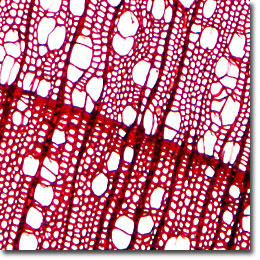The Yellow Birch
The Yellow Birch (Betula alleghaniensis) is a hardwood tree found primarily in the upland, hilly terrain of the northeastern and forests in the Great Lakes region. This specimen is one of the hardiest of all the broad-leaved trees. The sapwood ranges from white to pale yellow or light red-brown, while the heartwood is light to dark brown and occasionally reddish brown.

Cross Section

Radial Section

Tangential Section
A majority of the evergreen birch (Betulaceae) family are medium-tall deciduous trees that are more often grown for timber or aromatic properties than as an ornamental. The Betula genus has between 50 and 60 species, mostly from North America or Asia. The yellow birch is an ancient species that dates back to the Ice Age and although the tree is found as far south as the Carolinas, it thrives in cold northern climates. White-barked birches make beautiful winter photographs. Birch is the only tree species that is native to Iceland and Greenland.
Yellow birch wood is used for furniture, radio, television, and stereo cabinets, kitchen cabinets, boxes, crates, woodenware and novelties, and toys. Other uses include mill products, shuttles, spools, bobbins, and a variety of other turned articles, butcher blocks, agricultural implements, musical and scientific instruments and cases, toothpicks, and shoes pegs.
Microscopic examination of iron-alum hematoxylin and safranin stained thin sections (see the digital images presented above) reveals a diffuse and porous wood with scalariform perforation plates. Vessels are moderately numerous, and inter-vessel pits range from 2 to 4 micrometers in diameter (small in comparison to other common hardwoods), and are orbicular to broad-oval or angular (through crowding) in shape. Fiber tracheids are moderately thick-walled and medium to coarse in texture. The rays are unstoried, homocellular, and range from 1 to 5 seriate.